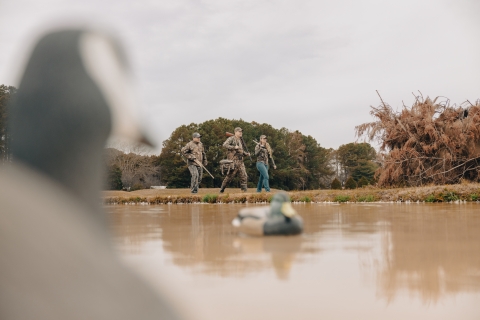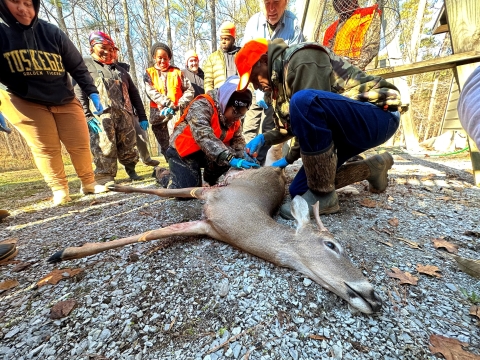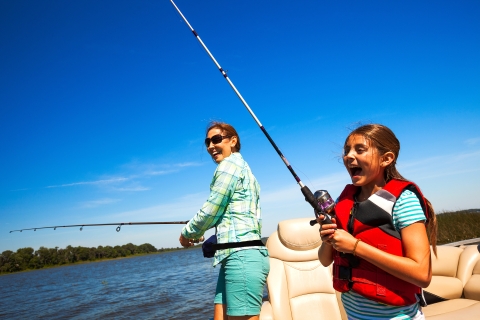On the fourth Saturday of every September, National Hunting and Fishing Day recognizes the nation’s hunters and anglers. While not all Americans participate in hunting and fishing, they are important outdoor activities that connect people to wild animals and wild places. For many it is a lifestyle and gateway to the outdoors and a connection to nature. These pastimes often bring together family and friends and create lasting memories. Hunting and fishing are also a fantastic activity to get kids outside and interacting with the environment. Studies show that time spent in nature positively affect child and adult health and well-being. This can be through lowering stress levels, increasing exercise, and even through the healthy lean protein harvested while hunting or fishing. Many state fish and wildlife agencies provide cooking guides full of recipes hunters and anglers use to feed their families and communities:
- Cooking Texas Style - This Texas Parks and Wildlife series showcases how Texans have been serving wild game to their families for generations as the original low-carb, low-fat, all-natural food. From venison to dove, turkey, or quail, the videos and recipes show healthy choices the whole family can enjoy.
- Kentucky Afield - Through this series the Kentucky Department of Fish & Wildlife Resources invites viewers into the kitchen to learn how to prepare freshly harvested meals like striper chowder and deer camp chili.
Beyond the connection to nature and human health benefits, hunting and fishing also support conservation and land stewardship. When President Nixon signed the first ever Presidential proclamation of National Hunting and Fishing Day he highlighted this conservation commitment, writing: "I urge all citizens to join with outdoor sportsmen in the wise use of our natural resources and in insuring their proper management for the benefit of future generations." While the inaugural National Hunting and Fishing Day took place in 1972, hunters and anglers have supported conservation for much longer through their commitment to sustainable practices and manufacturers excise taxes paid on sporting equipment.
Excise Tax from Hunting and Fishing Funds Conservation
Industry excise taxes have been crucial to American conservation since 1937, when pressure from conservation groups and the public helped pass the Federal Aid in Wildlife Restoration Act, known as Pittman-Robertson, followed in 1950 by the Federal Aid in Sport Fish Restoration Act, known as Dingell-Johnson. Managed through the U.S. Fish and Wildlife Service’s Wildlife and Sport Fish Restoration Program, these funds provide more than $1 billion a year to support fish and wildlife. Across the country, state and territory fish and wildlife agencies are on the front lines of conservation using Wildlife and Sport Fish Restoration funds as an indispensable part of their budget.
The excise taxes on firearms, ammunition, and archery equipment collected through the Wildlife Restoration Act have been one of America’s most effective tools for funding conservation. These excise tax funds are used by state fish and wildlife agencies to maintain public hunting access to tens of millions of acres, teach over 600,000 hunter education students annually, monitor and manage over 500 species of mammals and birds, and support nearly 800 firearm and archery target shooting ranges where the public can hone their skills.
- Federal Excise Taxes Fund Massive Public Hunting Area Purchase - The New Mexico Department of Game and Fish acquired the L-Bar Ranch in late 2022, through excise taxes paid by firearms, ammunition, and archery manufacturers. The new property expanded the existing Marquez Wildlife Management Area to 68,000 acres—106 square miles—of public land for hunters, birders, and nature enthusiasts.
- Supporting Outdoor Diversity and Access for Tuskegee University Students Through Hunter Education - Sergeant Bill Freeman and his colleagues at The Alabama Department of Conservation and Natural Resources are working to ensure the state’s wildlife and wild places are for everyone. These efforts have utilized Wildlife and Sport Fish Restoration Program funds to support hunter education courses and mentored hunting trips for students at Tuskegee University and other colleges in the state. Hunting and other outdoor related activities allow the public to enjoy the state’s recourses and become an active member in the stewardship of these resources.
- Elk Restoration in the Eastern United States - After being absent a century or more, elk have been restored to the eastern United States. With sweat-equity investments of dedicated wildlife biologists and conservation groups, and the reliable and consistent conservation funding made possible by the Wildlife Restoration Act, state fish and wildlife agencies in eight states now manage robust herds of elk. Kentucky alone went from 1,500 to 10,000 elk in two decades.
Since 1950, the excise taxes on fishing equipment and motorboat fuel collected through the Sport Fish Restoration Act have been used by state and territory fish and wildlife agencies to ensure clean water, healthy fish, and public access to waterways. With this funding state agencies teach over 1.5 million students’ aquatic education annually, raise and release over 1 billion fish annually into waterways, and funded over 8900 public boating and fishing areas.
- Steelhead Restoration - For more than half a century, America’s fishing equipment manufacturers have shared a partnership with state and federal agencies through the Dingell-Johnson Act. Hear from the industry, state, and federal partners supporting steelhead restoration work through these excise tax funds.
- Casting A Fly Rod To Apache Trout Is A Testament To Perseverance - The U.S. Fish and Wildlife Service announced a proposal to delist the Apache trout at an event with the White Mountain Apache Tribe, the U.S. Forest Service, the Arizona Game and Fish Department, and Trout Unlimited. The Apache trout stands to be the first sport fish species to be recovered and removed from the federal list of threatened and endangered species.
- Rio Grande cutthroat trout—a Model for Fisheries Conservation – Supported through Sport Fish Restoration dollars, biologists with Colorado Parks and Wildlife and the New Mexico Department of Game and Fish are working to conserve Rio Grande cutthroat trout.
Wildlife Management Through Hunting and Fishing
Hunting and fishing can be beneficial as wildlife management tools to maintain the health and abundance of wildlife species and the balance of our natural resources. Hunting and fishing can also be tools to decrease invasive species invasive species
An invasive species is any plant or animal that has spread or been introduced into a new area where they are, or could, cause harm to the environment, economy, or human, animal, or plant health. Their unwelcome presence can destroy ecosystems and cost millions of dollars.
Learn more about invasive species and control wildlife diseases.
- Funding Wildlife Health Labs - Wildlife and Sport Fish Restoration funds are protecting the health of our nation’s fish and wildlife by funding over 35 laboratories conducting disease surveillance and response.
- Game Mammal Study Across Hawaiian Islands Can Support Hunters and Endangered Species - There are two main strategies for controlling invasive game mammals throughout the Hawaiian Islands: putting up fences and hunting. With funding through the Wildlife and Sportfish Restoration Program, the Division of Forestry and Wildlife at Hawai’i’s Department of Land and Natural Resources is using island wide surveys to study what areas non-native game mammals are using, how to manage existing hunting areas, and even how hunting could be a tool to protect sensitive species and ecosystems.
Find Hunting and Fishing Opportunities Near You
Visit your state’s fish and wildlife agency website or local office for resources on hunting and fishing and information on licenses, permits, and regulations. Additional resources to get started can be found at:
State fish and wildlife agencies own and operate tens of millions of acres of Wildlife Management Areas (WMAs) around the nation. WMAs and state game lands offer a chance to connect with nature including opportunities for hunting, fishing, boating, and wildlife-based activities These public lands are operated and maintained as a result of funding from two sources including excise tax paid by companies who manufacture sporting arms, ammunition, archery equipment, and fishing gear as well as state licenses, permits and stamp revenues paid by hunters, trappers, and anglers.
State agencies also provide boating access sites that are designed, constructed, and maintained with excise tax funds. Visit your local boating access site for waterway access.
Additional hunting and fishing opportunities are available at many national wildlife refuges and national fish hatcheries. Find a location near you at www.fws.gov/initiative/hunting/hunting-us-fish-and-wildlife-service-lands-and-waters and www.fws.gov/fishing/map.







